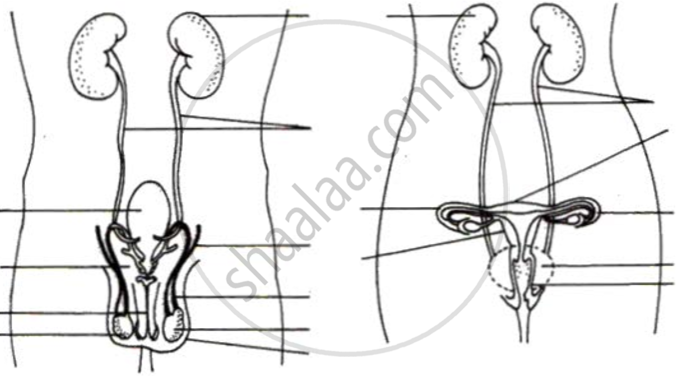Advertisements
Advertisements
प्रश्न
Explain the process of development in human beings.
उत्तर
Development:
- Fertilisation results in the formation of zygote.
- The zygote divides and redivides to form a ball of cells called blastocyst.
- The blastocyst gets implanted on the wall of the uterus and forms the embryo.
- The embryo obtains all the nourishment and oxygen from the mother’s blood.
- A structure called placenta present in the uterus supplies all the necessary nutrients to the embryo through the umbilical cord.
- The development of the foetus takes place for nine months
APPEARS IN
संबंधित प्रश्न
Find the odd one out and write it: vagina, uterus, vas deferens, ovary
Explain the process of birth in human beings.
Name the parts of the human female reproductive system where
i. fertilisation takes place
ii. implantation of the fertilised egg occurs
Draw a sectional view of human female reproductive system and label the part where
(i) eggs develop.
(ii) fertilisation takes place.
(iii) fertilised egg gets implanted.
List two functions ovary of human female reproductive system.
Newly formed DNA copies may not be identical at times. Give one reason.
Why are testes located outside the abdominal cavity? What is responsible for bringing about changes in appearance seen in boys at the time of puberty?
The diagram given below is that of a developing human foetus. Study the diagram and then answer the questions that follow:

(i) Label the parts numbered 1 to 3 in the diagram.
(ii) Mention any two functions of the part labelled 2 in the diagram.
(iii) Explain the significance of the part numbered 3 in the diagram.
(iv) Define the term ‘Gestation’. What is the normal gestational period of the developing human embryo?
(v) Mention the sex chromosomes in a male and female embryo.
The structure formed by the villi of the embryo and the uterus of the mother.
A single highly coiled tube where sperms are stored gets concentrated, and mature is known as ______
fill in the blanks with suitable functions: Seminiferous Tubule and _____
Which part of the human body produces ova?
What do the testes in a man produce?
Where in the human body does an ovum get fertilised?
Fill in the following blank with suitable word :
The menstrual cycle is controlled by.............
Mention two functions of human ovaries.
What is the role of seminal vesicles and prostrate gland in human male reproductive system?
Name the organs which produce ova (or egg cells) in human females.
The normal body cell of an organism contains 28 pairs of chromosomes. The number of chromosomes present in its germ cell will be
(a) 28
(b) 14
(c) 56
(d) 42
When a female child is born, her ovaries already contain thousands of immature eggs (or ova) contained in immature structures A. On maturing, A bursts open and an egg shoots out of the ovary in a process called B. The process B starts in the females at puberty and occurs again and again after a time period x. Before every occurrence of process B, the inner lining of uterus becomes thick and soft with lots of blood vessels in it. When the egg cell gets fertilised by a sperm, then an event C occurs in the life of mature human female which lasts for time period y leading to the birth of baby. If, however, the egg cell released by the ovary does not get a sperm to fuse with, then the thick and soft inner lining of uterus breaks down and comes out of the female's body in an event called D. The occurrence of event D is controlled by chemical substances E.
(a) What are A?
(b) What is process B?
(c) What is the time period x?
(d) Name the event C.
(e) How much is the time period y?
(f) What is the name of process D?
(g) Name the chemical substances E.
The normal gestation period in humans is:
Rewrite the terms in the correct order so as to be in a logical sequence.
Implantation, ovulation, child birth, gestation, fertilisation.
Give the names.
Any two sexual diseases.
The vagina is a muscular tube.
Give the function of the following:
Uterus
Label the folowing diagram

The below diagram is of a developing embryo is a mother’s womb:

(i) Write the functions of the placenta, amnion, and umbilical cord.
(ii) How are the waste products of a fetus removed?
(iii) What is the gestation period?
Explain the term Parturition or birth.
Name the Following
What does this abbreviation stand for IUD?
Choose the Odd One Out:
Choose the Odd One Out:
Choose the Odd One Out:
What is the composition of semen?
Testosterone is produced by:
Gestation period in man
Arrange and rewrite the terms in the group in the correct order to be in a logical sequence beginning with the term that is underlined:
Testis, Urethra, Sperm duct, epididymis.
